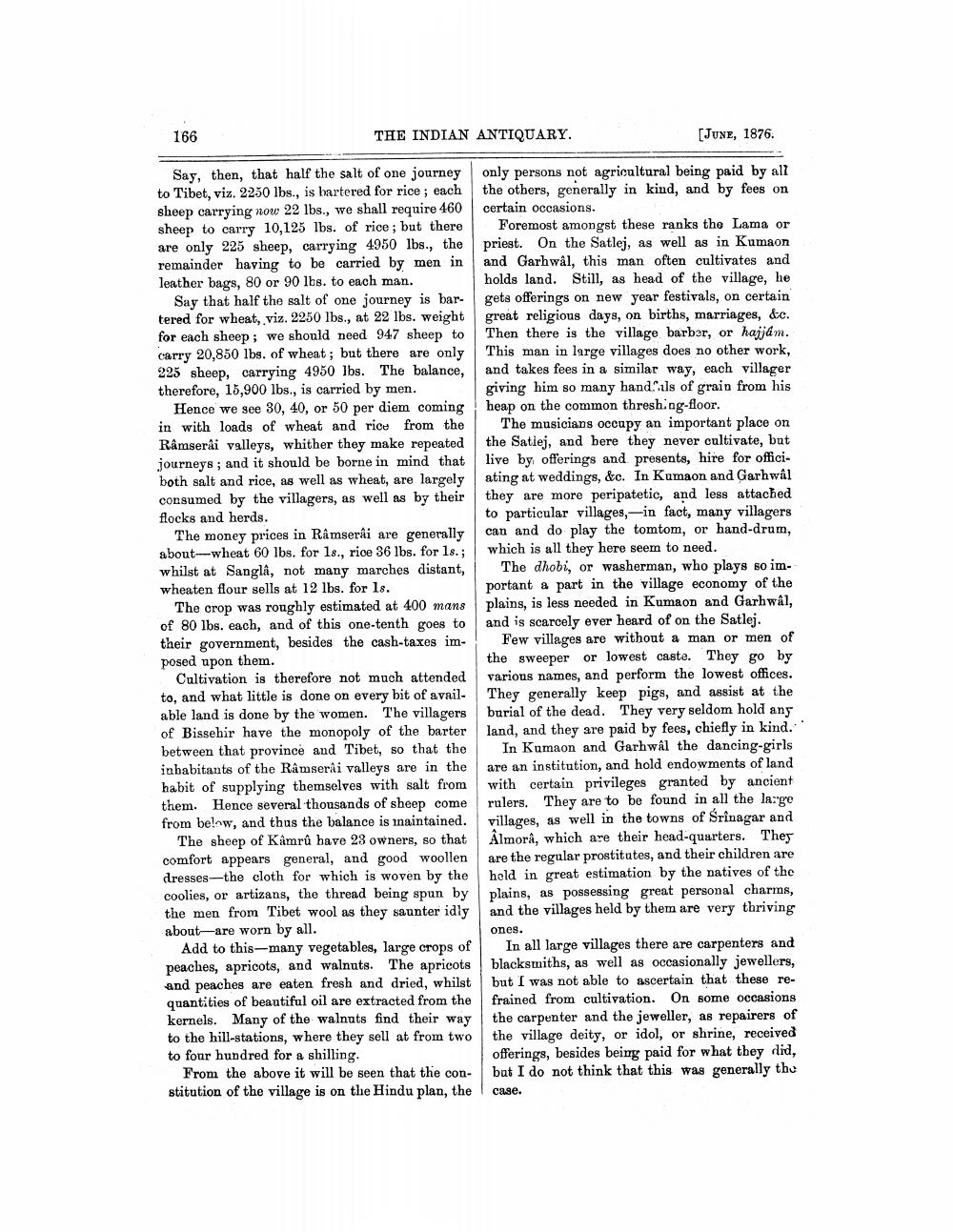________________
166
THE INDIAN ANTIQUARY.
Say, then, that half the salt of one journey to Tibet, viz. 2250 lbs., is bartered for rice; each sheep carrying now 22 lbs., we shall require 460 sheep to carry 10,125 lbs. of rice; but there are only 225 sheep, carrying 4950 lbs., the remainder having to be carried by men in leather bags, 80 or 90 lbs. to each man.
Say that half the salt of one journey is bartered for wheat, viz. 2250 lbs., at 22 lbs. weight for each sheep; we should need 947 sheep to carry 20,850 lbs. of wheat; but there are only 225 sheep, carrying 4950 lbs. The balance, therefore, 15,900 lbs., is carried by men.
Hence we see 30, 40, or 50 per diem coming in with loads of wheat and rice from the Râmserâi valleys, whither they make repeated journeys; and it should be borne in mind that both salt and rice, as well as wheat, are largely consumed by the villagers, as well as by their flocks and herds.
The money prices in Râmserâi are generally about-wheat 60 lbs. for 1s., rice 36 lbs. for 1s.; whilst at Sanglâ, not many marches distant, wheaten flour sells at 12 lbs. for 18.
The crop was roughly estimated at 400 mans of 80 lbs. each, and of this one-tenth goes to their government, besides the cash-taxes imposed upon them.
Cultivation is therefore not much attended to, and what little is done on every bit of available land is done by the women. The villagers of Bissehir have the monopoly of the barter between that province and Tibet, so that the inhabitants of the Râmserâi valleys are in the habit of supplying themselves with salt from them. Hence several thousands of sheep come from below, and thus the balance is maintained.
The sheep of Kamrû have 23 owners, so that comfort appears general, and good woollen dresses the cloth for which is woven by the coolies, or artizans, the thread being spun by the men from Tibet wool as they saunter idly about-are worn by all.
Add to this-many vegetables, large crops of peaches, apricots, and walnuts. The apricots and peaches are eaten fresh and dried, whilst quantities of beautiful oil are extracted from the kernels. Many of the walnuts find their way to the hill-stations, where they sell at from two to four hundred for a shilling.
From the above it will be seen that the constitution of the village is on the Hindu plan, the
[JUNE, 1876.
only persons not agricultural being paid by all the others, generally in kind, and by fees on certain occasions.
Foremost amongst these ranks the Lama or priest. On the Satlej, as well as in Kumaon and Garhwâl, this man often cultivates and holds land. Still, as head of the village, he gets offerings on new year festivals, on certain great religious days, on births, marriages, &c. Then there is the village barber, or hajjám. This man in large villages does no other work, and takes fees in a similar way, each villager giving him so many hand als of grain from his heap on the common threshing-floor.
The musicians occupy an important place on the Satlej, and here they never cultivate, but live by offerings and presents, hire for officiating at weddings, &c. In Kumaon and Garhwâl they are more peripatetic, and less attached to particular villages,-in fact, many villagers can and do play the tomtom, or hand-drum, which is all they here seem to need.
The dhobi, or washerman, who plays so im-portant a part in the village economy of the plains, is less needed in Kumaon and Garhwal, and is scarcely ever heard of on the Satlej.
Few villages are without a man or men of the sweeper or lowest caste. They go by various names, and perform the lowest offices. They generally keep pigs, and assist at the burial of the dead. They very seldom hold any land, and they are paid by fees, chiefly in kind.
In Kumaon and Garhwâl the dancing-girls are an institution, and hold endowments of land with certain privileges granted by ancient rulers. They are to be found in all the large villages, as well in the towns of Srinagar and Almorâ, which are their head-quarters. They are the regular prostitutes, and their children are held in great estimation by the natives of the plains, as possessing great personal charms, and the villages held by them are very thriving
ones.
In all large villages there are carpenters and blacksmiths, as well as occasionally jewellers, but I was not able to ascertain that these refrained from cultivation. On some occasions the carpenter and the jeweller, as repairers of the village deity, or idol, or shrine, received offerings, besides being paid for what they did, but I do not think that this was generally the
case.




